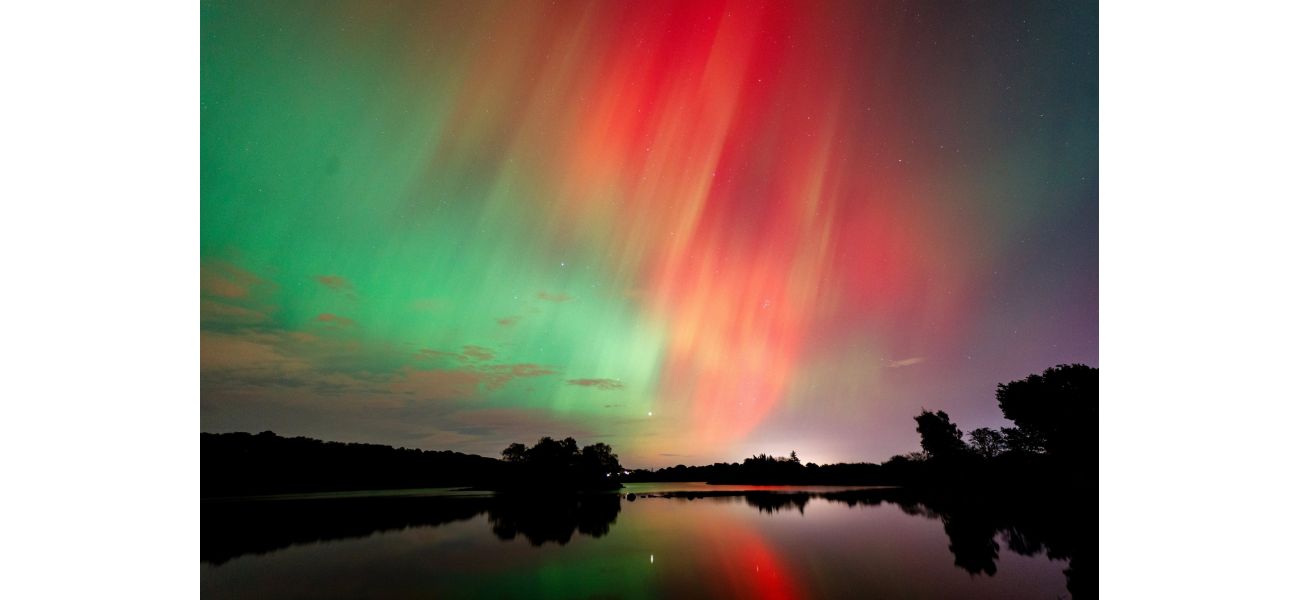Why are we witnessing an increase in Northern Lights sightings in more southern regions?
It seems like I should be traveling and paying to see the sights in Iceland or Finland.
October 11th 2024.

Have you ever seen the Aurora Borealis? It's not something you expect to witness, especially at this time of year, in the middle of the day, in your own backyard. But that's exactly what happened to Josh Yonish, a 22-year-old geologist from London. He couldn't believe his luck when he caught a glimpse of the Northern Lights, right there in his light-polluted city.
For most people, seeing the Northern Lights is a once-in-a-lifetime experience. But for Josh, it was a familiar sight. He had already seen them in Birmingham back in May, and he wasn't the only one. Many Britons had also been lucky enough to witness this natural wonder. And now, here they were again, dancing above the night sky in stripes of green, blue, pink, and purple, as the stars began to twinkle.
"It felt surreal," Josh tells Metro. "To see one of the seven natural wonders of the world from my bedroom window in northeast London on a cold October night was truly incredible. I feel like I should be paying to go to Iceland or Finland to see them, so I'm grateful for this unexpected opportunity."
But why has the UK been seeing the Northern Lights so frequently this year? What exactly are they? The Aurora Borealis appears as ethereal curtains that stretch across the night sky. The name itself gives a hint as to where they are seen - only in the northern hemisphere. Their southern counterpart, the Aurora Australis, can be seen near the South Pole.
So, what causes this magnificent display? The Earth has a magnetic field that acts as a protective shield, keeping harmful particles away. When the sun's nuclear reactions cause it to "burp," it releases plasma blobs into space. These particles, along with others, travel at high speeds towards the Earth. When they collide with our magnetic field, they are pushed towards the poles. As they interact with the particles already trapped in the magnetic field, they create a stunning light show.
Each particle has a distinct hue, which is why the Northern Lights are so colorful. Oxygen, for example, has a greenish hue, while nitrogen can appear red. When these particles collide with the trapped particles, they light up, creating the beautiful display we see.
But why have we been seeing the Northern Lights so often lately? Usually, they can only be seen in places like Iceland, Scandinavia, Canada, and Alaska. However, this year, a larger area of the Northern Hemisphere has been treated to this breathtaking phenomenon.
"The reason we're seeing more Northern Lights events, the Aurora Borealis, here in the UK, is that we are near a solar maximum," explains Jo Farrow, a forecaster for Netweather. A solar maximum is a period in the sun's 11-year cycle when it is particularly active. This means more sunspots, solar flares, and coronal mass ejections (CMEs). These CMEs are responsible for the geomagnetic storms that cause the Northern Lights.
Just last night, a "severe" geomagnetic storm hit the UK, causing the Northern Lights to appear even more vibrant. "In a time of solar maximum, there are more sunspots, more solar flares, more CMEs, and more energized particles for the solar wind to bring towards Earth," adds Farrow. "When a CME is 'Earth-directed,' it can cause auroras to be seen in any direction. There have been some very large flares recently, including a G5 geomagnetic storm in May and a G4 storm last night, both of which coincided with clear skies for some parts of the UK."
But why have the Northern Lights been seen so far south this year? Normally, the closer you are to the equator, the less likely you are to witness this phenomenon. However, during solar storms, the chances increase. "These solar flare ejections from the sun's surface can be huge, as we saw last night, which is why we are seeing displays in southern areas, which is very unusual," explains Jim N R Dale, a senior meteorological consultant.
If you're lucky enough to catch a glimpse of the Northern Lights, you may want to capture the moment on camera. But photographing them can be tricky, especially in the dark. However, modern smartphones like the Samsung Galaxy S24 FE have features like Night Mode, which automatically adjusts the settings to capture the best shots in low light. So, even if you can't travel to Iceland, you can still have a stunning photo of the Northern Lights.
If you're hoping to see the Northern Lights for yourself, keep an eye on AuroraWatch UK, which provides updates on sightings. And don't worry if you miss them tonight - there's always a chance they'll appear again tomorrow. After all, Josh wouldn't mind seeing them again either, especially since it's much cheaper than a trip to Iceland. "My favorite thing was how they changed between every photo I took," he says. "Even though I couldn't see them with my naked eye, it felt like I was watching a massive light show. Truly unforgettable."
For most people, seeing the Northern Lights is a once-in-a-lifetime experience. But for Josh, it was a familiar sight. He had already seen them in Birmingham back in May, and he wasn't the only one. Many Britons had also been lucky enough to witness this natural wonder. And now, here they were again, dancing above the night sky in stripes of green, blue, pink, and purple, as the stars began to twinkle.
"It felt surreal," Josh tells Metro. "To see one of the seven natural wonders of the world from my bedroom window in northeast London on a cold October night was truly incredible. I feel like I should be paying to go to Iceland or Finland to see them, so I'm grateful for this unexpected opportunity."
But why has the UK been seeing the Northern Lights so frequently this year? What exactly are they? The Aurora Borealis appears as ethereal curtains that stretch across the night sky. The name itself gives a hint as to where they are seen - only in the northern hemisphere. Their southern counterpart, the Aurora Australis, can be seen near the South Pole.
So, what causes this magnificent display? The Earth has a magnetic field that acts as a protective shield, keeping harmful particles away. When the sun's nuclear reactions cause it to "burp," it releases plasma blobs into space. These particles, along with others, travel at high speeds towards the Earth. When they collide with our magnetic field, they are pushed towards the poles. As they interact with the particles already trapped in the magnetic field, they create a stunning light show.
Each particle has a distinct hue, which is why the Northern Lights are so colorful. Oxygen, for example, has a greenish hue, while nitrogen can appear red. When these particles collide with the trapped particles, they light up, creating the beautiful display we see.
But why have we been seeing the Northern Lights so often lately? Usually, they can only be seen in places like Iceland, Scandinavia, Canada, and Alaska. However, this year, a larger area of the Northern Hemisphere has been treated to this breathtaking phenomenon.
"The reason we're seeing more Northern Lights events, the Aurora Borealis, here in the UK, is that we are near a solar maximum," explains Jo Farrow, a forecaster for Netweather. A solar maximum is a period in the sun's 11-year cycle when it is particularly active. This means more sunspots, solar flares, and coronal mass ejections (CMEs). These CMEs are responsible for the geomagnetic storms that cause the Northern Lights.
Just last night, a "severe" geomagnetic storm hit the UK, causing the Northern Lights to appear even more vibrant. "In a time of solar maximum, there are more sunspots, more solar flares, more CMEs, and more energized particles for the solar wind to bring towards Earth," adds Farrow. "When a CME is 'Earth-directed,' it can cause auroras to be seen in any direction. There have been some very large flares recently, including a G5 geomagnetic storm in May and a G4 storm last night, both of which coincided with clear skies for some parts of the UK."
But why have the Northern Lights been seen so far south this year? Normally, the closer you are to the equator, the less likely you are to witness this phenomenon. However, during solar storms, the chances increase. "These solar flare ejections from the sun's surface can be huge, as we saw last night, which is why we are seeing displays in southern areas, which is very unusual," explains Jim N R Dale, a senior meteorological consultant.
If you're lucky enough to catch a glimpse of the Northern Lights, you may want to capture the moment on camera. But photographing them can be tricky, especially in the dark. However, modern smartphones like the Samsung Galaxy S24 FE have features like Night Mode, which automatically adjusts the settings to capture the best shots in low light. So, even if you can't travel to Iceland, you can still have a stunning photo of the Northern Lights.
If you're hoping to see the Northern Lights for yourself, keep an eye on AuroraWatch UK, which provides updates on sightings. And don't worry if you miss them tonight - there's always a chance they'll appear again tomorrow. After all, Josh wouldn't mind seeing them again either, especially since it's much cheaper than a trip to Iceland. "My favorite thing was how they changed between every photo I took," he says. "Even though I couldn't see them with my naked eye, it felt like I was watching a massive light show. Truly unforgettable."
[This article has been trending online recently and has been generated with AI. Your feed is customized.]
[Generative AI is experimental.]
0
0
Submit Comment





